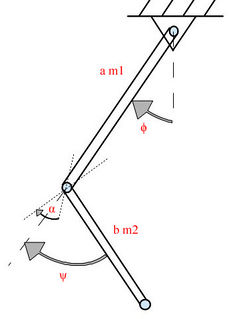Dzenushko Dainis. Course project for theoretical mechanics "Double pendulum" — различия между версиями
Dainis (обсуждение | вклад) (→Task) |
Dainis (обсуждение | вклад) (→Решение) |
||
| Строка 17: | Строка 17: | ||
*find the equation of motion for this double pendulum | *find the equation of motion for this double pendulum | ||
| − | == | + | == Solution == |
| − | ''' | + | '''Let's find the way of solving this problem:''' We are going to solve the problem by using the Lagrange equation:<br> |
<math>\frac{d}{dt}\frac{\partial T}{\partial \dot{q}_i}-\frac{\partial T}{\partial q_i} = -\frac{\partial \Pi}{\partial q_i}+Q_i</math><br> | <math>\frac{d}{dt}\frac{\partial T}{\partial \dot{q}_i}-\frac{\partial T}{\partial q_i} = -\frac{\partial \Pi}{\partial q_i}+Q_i</math><br> | ||
| − | *<math>T</math> - | + | *<math>T</math> - Kinetic energy of system <br> |
| − | *<math>\Pi</math> - | + | *<math>\Pi</math> - Potential energy of system<br> |
| − | *<math>q_i</math> - | + | *<math>q_i</math> - Generalized coordinates<br> |
| − | *<math>\dot{q}_i</math> - | + | *<math>\dot{q}_i</math> - generalized velocities<br> |
| − | *<math>Q_i</math> - | + | *<math>Q_i</math> - generalized non-potential forces<br> |
<br> | <br> | ||
| − | ''' | + | '''Selecting generalized coordinates:''' for generalized coordinates we are going to use angles <math>\varphi</math> and <math>\psi</math> <br> |
| − | * | + | *In this problem we neglect non-potential interactions, so generalized non-potential forces equals to zero.<br> |
| − | ''' | + | '''Calculating potential and kinetic energy of system:''' <math>\Pi_1 , T_1 ; \Pi_2 , T_2 </math> of first and second rods relatively.<br> <math>\Pi = \Pi_1 + \Pi_2</math> - Potential energy of system<br> |
| − | <math>T = T_1 + T_2</math> - | + | <math>T = T_1 + T_2</math> - Kinetic energy of system<br> |
| − | <math>T_1 = \frac{\underline{\omega}_1 \cdot \underline{\underline{\Theta}}_1 \cdot \underline{\omega}_1}{2} = \frac{\Theta_1 \omega_1^2}{2} = \frac{\Theta_1 \dot{\varphi}^2}{2}</math> - | + | <math>T_1 = \frac{\underline{\omega}_1 \cdot \underline{\underline{\Theta}}_1 \cdot \underline{\omega}_1}{2} = \frac{\Theta_1 \omega_1^2}{2} = \frac{\Theta_1 \dot{\varphi}^2}{2}</math> - Kinetic energy of first rod; Where |
| − | <math>\qquad \Theta_1 = \frac{m_1 a^2}{3}</math> - | + | <math>\qquad \Theta_1 = \frac{m_1 a^2}{3}</math> - Inertia torque of first rod<br> |
| − | <math>\Pi_1 = m_1 g \left( \frac{a}{2} - \frac{a}{2} \cos \varphi \right)</math> - | + | <math>\Pi_1 = m_1 g \left( \frac{a}{2} - \frac{a}{2} \cos \varphi \right)</math> - Potential energy of first rod<br> |
| − | <math>T_2 = \frac{\underline{\omega}_2 \cdot \underline{\underline{\Theta}}_2 \cdot \underline{\omega}_2}{2} + \frac{m_2 \vartheta_c^2}{2}</math> - | + | <math>T_2 = \frac{\underline{\omega}_2 \cdot \underline{\underline{\Theta}}_2 \cdot \underline{\omega}_2}{2} + \frac{m_2 \vartheta_c^2}{2}</math> - Kinetic energy of second rod<br> |
<math>\underline{\omega}_2 = ?</math><br><br> | <math>\underline{\omega}_2 = ?</math><br><br> | ||
Версия 00:24, 30 июля 2012
Содержание
Subject
Specification of double pendulum oscillations
Task
Rod is connected to the roof by cylindrical joint. The second rod is connected to the end of the first rod via cylindrical joint so that when both rods are vertical the angle between joint's axis equals to . Dissipative forces are not taken to account.
System parameters:
- Inertia tensor of first and second rods are equal. and respectively.
- length of rods are a and b, their masses and for first and second rods.
- Angle between rotation axis of joints equals to
- - angle between first rod and vertical direction
- - angle between axis of first and second rods that means the angle in second joint relative to vertical orientation of system.
Main task:
- find the equation of motion for this double pendulum
Solution
Let's find the way of solving this problem: We are going to solve the problem by using the Lagrange equation:
- - Kinetic energy of system
- - Potential energy of system
- - Generalized coordinates
- - generalized velocities
- - generalized non-potential forces
Selecting generalized coordinates: for generalized coordinates we are going to use angles and
- In this problem we neglect non-potential interactions, so generalized non-potential forces equals to zero.
Calculating potential and kinetic energy of system: of first and second rods relatively.
- Potential energy of system
- Kinetic energy of system
- Kinetic energy of first rod; Where
- Inertia torque of first rod
- Potential energy of first rod
- Kinetic energy of second rod
Найдем вектор угловой скорости второго стержня:
Для нахождения найдем тензоры поворота первого и второго стержней
Где:
- ось вращения второго стержня в данном положении
- ось вращения второго стержня в начальном положении
- полный тензор поворота второго стержня
Но:
Теперь применяя формулу сложения угловых скоростей получим:
Таким образом получаем что:
Найдем скорость центра масс второго стержня
Найдем кинетическую энергию второго стержня
Запишем тензор инерции второго стержня:
Теперь мы нашли все необходимое для подставления в формулу для кинетической энергии второго стержня:
Найдем потенциальную энергию второго стержня
- радиус-вектор центра масс второго стержня
Получение уравнения движения
Продифференцируем полученные выражения для потенциальной и кинетической энергий, как это требует уравнение Лагранжа и подставим полученное в него. В результате получим систему из двух дифференциальных уравнений которые описывают движение системы.
Заметим что данный метод решения дает нам уравнение движения для больших углов, в случае необходимости его можно линеаризовать предположив что углы малы и отбросив слагаемые второго порядка.
Применение метода решения для частного случая
Проверим описанный выше метод в частном случае при
В таком случае задача сводится к двухмерной.
Найдем тензоры поворота
Найдем угловую скорость второго стержня
Найдем скорость центра масс
Найдем кинетическую энергию второго стержня
Найдем потенциальную энергию второго стержня
Найдем кинетическую и потенциальную энергии первого стержня
Получение уравнения движения для частного случая
Запишем выражения для полной кинетической и потенциальной энергий:
Теперь продифференцируем энергии и произведем линеаризацию полученного результата предполагая что малые углы оставив только бесконечно малые первого порядка. В результате получим уравнение движения:
Обсуждение результатов и выводы
В данной работе был подробно описан алгоритм решения задачи о двойном маятнике в случае когда оба шарнира циллиндрические. Затем данный метод был применен для частного случая плоской задачи.
